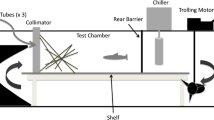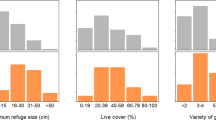Synopsis
The schooling behavior and interspecific interactions within a nearshore planktivorous fish aggregation in Bermuda was observed during the summer (July–Sept) and winter (Dec–Jan) of 1986–87. Four species of morphologically and ecologically similar fish were, studied: the silverside Allanetta harringtonensis, the round herring Jenkensia lamprotaenia, the anchovy Anchoa choerostoma, and the pilchard Harengula humeralis. Heterospecific aggregations of these fish layered with depth into discrete horizontal bands 30 to 60 cm in width. Layers were categorized by unique sets of species as well as by age offish (measured as fish length). The median depth of the layer was also a function of whether the fish were feeding or resting. The median depth and the width of each layer were consistent across three sites and midmorning versus midafternoon observation times. Reduction in predation per individual is suggested as a possible force acting to maintain the structure of this fish aggregation.
Similar content being viewed by others
References cited
Barlow, G.W. 1974. Contrasts in social behavior between Central American cichlid fishes and coral-reef surgeon fishes. Amer. Zool. 14: 9–34.
Brandt, S.B. 1986. Ontogenetic shifts in habitat, diet and dielfeeding periodicity of slimy sculpin in Lake Ontario. Trans. Amer. Fish. Soc. 115: 711–715.
Brewer, G.D. & G.S. Kleppel. 1986. Diel vertical distribution of fish larvae and their prey in nearshore waters of southern California. Mar. Ecol. Prog. Ser. 27: 217–226.
Brock, V.E. & R.N. Riffenburgh. 1960. Fish schooling: a possible factor in reducing predation. J. Cons. 25: 307–317.
Engel, S. & J.J. Magnuson. 1976. Vertical and horizontal distribution of coho salmon (Oncorhynchus kisutch), yellow perch (Perca flavescens), and cisco (Coregonus artedii) in Pallette Lake, Wisconsin. J. Fish. Res. Board Can. 33: 2710–2715.
Foster, W.A. & H.E. Treherne. 1981. Evidence for the dilution effect in the selfish herd from fish predation on a marine insect. Nature 293: 466–467.
Gosling, L.M. 1980. Defense guilds of savannah ungulates as a context for scent communication. Symp. Zool. Soc. London 45: 195–212.
Hamilton, W.D. 1971. Geometry for the selfish herd. J. Theor. Biol. 31: 295–311.
Hobson, E.S. 1963. Selective feeding by the gafftopsail pompano, Trachinotus rhodopus (Gill), in mixed school of herring and anchovies in the Gulf of California. Copeia 1963: 595–596.
Hobson, E.S. 1968. Predatory behavior of some shore fishes in the Gulf of California. Res. Rept. US Fish. Wildl. Serv. 73: 1–92.
Itzkowitz, M. 1977. Social dynamics of mixed-species groups of Jamaican reef fishes. Behav. Ecol. Sociobiol. 2: 361–384.
Krebs, J.R. 1973. Experiments on the significance of mixed species flocks of chickadees. Can. J. Zool. 51: 1275–1288.
Landeau, L. & J. Terborgh. 1986. Oddity and the ‘confusion effect’ in predation. Anim. Behav. 34: 1372–1380.
Major, P.F. 1977. Predator-prey interactions in schooling fishes during periods of twilight: a study of the silverside Pranesus insularum in Hawaii. U.S. Fish. Bull. 75: 415–426.
Matsumoto, W.M., R.A. Skillman & A.E. Dizon. 1984. Synopsis of biological data on skipjack tuna, Katsuwonus pelamis. NOAA Tech. Rept. NMFS Circular 451. FAO Fisheries Synopsis 136: 46–53.
Mendelson, J. 1975. Feeding relationships among species of Notropis (Pisces: Cyprinidae) in a Wisconsin stream. Ecol. Monog. 45: 199–230.
Morse, D. 1977. Feeding behavior and predator avoidance in heterospecific groups. BioScience 27: 332–339.
Mueller, H.C. 1975. Hawks select odd prey. Science 188: 953–954.
Pitcher, T.J. 1986. Functions of shoaling behaviour in teleosts. pp. 294–337 In: T.J. Pitcher (ed.) The Behaviour of Teleost Fishes, Croom Helm, London.
Rudstam, L.G. & J.J. Magnuson. 1985. Predicting the vertical distribution of fish populations: analysis of cisco, Coregonus artedii, and yellow perch, Perca flavescens. Can. J. Fish. Aquat. Sci. 42: 1178–1188.
Springer, S. 1957. Some observations in the behavior of schools of fishes in the Gulf of Mexico and adjacent waters. Ecology 38: 166–171.
Underwood, A.J. & E.J. Denley, 1984. Paradigms, explanations and generalizations in models for the structure of intertidal communities on rocky shores. pp. 151–180. In: D.R. Strong Jr., D. Simberloff, L.G. Abele & A.B. Thistle (ed.) Ecological Communities: Conceptual Issues and the Evidence, Princeton University Press, Princeton.
Wolf, N.G. 1985. Odd fish abandon mixed-species groups when threatened. Behav. Ecol. Sociobiol. 17: 47–52.
Yuen, H.S.H. 1962. Schooling behavior within aggregations composed of yellowfin and skipjack tuna. FAO Fisheries Reports No. 6, 3: 1419–1429.
Author information
Authors and Affiliations
Rights and permissions
About this article
Cite this article
Parrish, J.K. Layering with depth in a heterospecific fish aggregation. Environ Biol Fish 26, 79–85 (1989). https://doi.org/10.1007/BF00001024
Received:
Accepted:
Issue Date:
DOI: https://doi.org/10.1007/BF00001024




